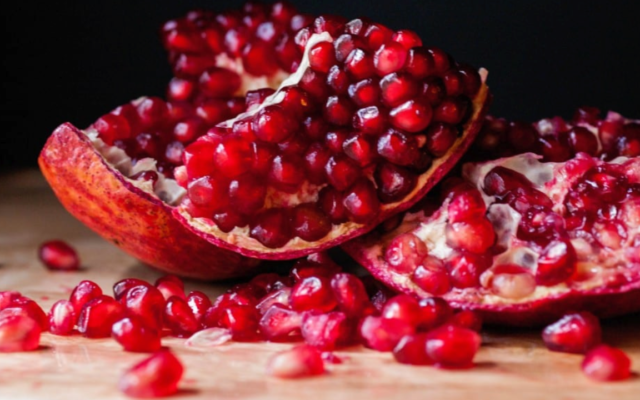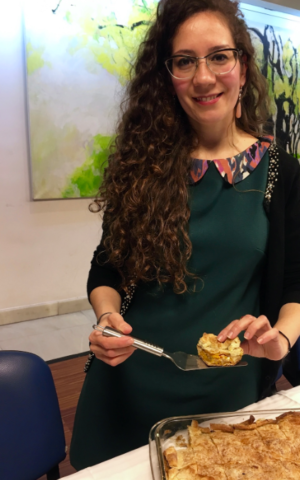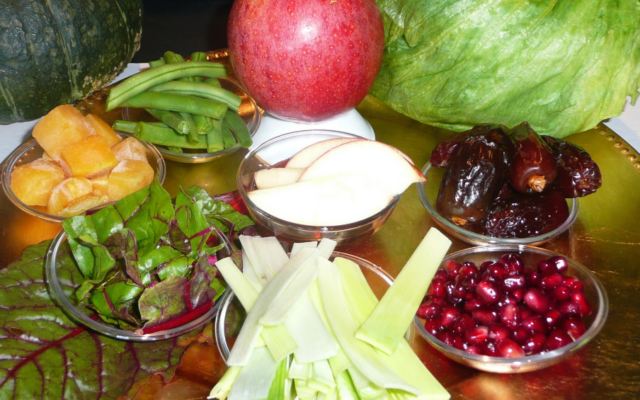Sephardic Jews Start Rosh Hashanah with A Seder
Traditional celebrations include a seder plate with up to nine different foods.
For Sephardic Jewish communities around the world, Rosh Hashanah is a time for incorporating a seder into the observance of the holiday. Like its more well-known counterpart at Passover, the Rosh Hashanah seder incorporates a seder plate with up to nine foods called in Hebrew, simanim, or signs that anticipate the hopes and wishes for the New Year.
Traditionally, it is held just before the important meal on Rosh Hashanah eve, and it incorporates not only a blessing over the familiar apples dipped in honey but also such lesser known species as leeks, beans, and squash. Much like the Southern tradition of eating black eyed peas to accompany a wish for prosperity on the secular New Year, each of the foods carries a yeti ratzon that begins each blessing and elaborates on a specific idea for the year to come.
At Congregation Or Ve Shalom in Atlanta, which was founded by Jews from the Greek island of Rhodes over a hundred years ago, the seder ritual at Rosh Hashanah is seen as a way to make certain the New Year begins right. The synagogue’s rabbi, Josh Hearshen, even notes that tradition calls for two truly unusual items.
“There’s a tradition to add a sheep’s head which reminds us of the binding of Isaac in the biblical story or a fish head. My family generally doesn’t do either. So we just add a piece of salmon to our seder plate,” he said.
Fish are said to have a long tradition of being associated with mystical powers such as creation, fertility and prosperity. In Ashkenazic tradition a fish course, such as gefilte fish, is usually served during the holiday. The fish head, according to the rabbi is to remind us that we need to lead the way in the year ahead and not just follow along like a fish’s tail.

The yeti ratzon in this case reads: “May it be your will, G-d and G-d of our ancestors that we be a head and not a tail.”
The origin of the Rosh Hashanah seder practice is said to originate over 1500 years ago to a short passage in the Babylonian Talmud. In the tractate Horayot, 12A, Rabbi Abaye spoke of such foods as squash, fenugreek, leeks and chard as foods that should always be seen on the holiday because they grow quickly and so should serve “as positive omens during the coming year.”
In some Sephardi homes the blessings over the foods are followed by a piyyut or religious verse composed by poets in medieval Spain. The Sephardic writer, Rahel Musleah, who grew up in Calcutta, India remembers, at his seder the poem by the 13th century Spanish author Abraham Hazzan Girondi which contains a chorus after each verse that says, in Hebrew “Tikhleh shanah ve-killeloteha! Let the year end with all its curses!” The poem concludes with “Let the New Year begin with all its blessings!”

The idea of incorporating a seder into New Year rituals is increasingly being picked up by others, outside traditional Sephardic practice. In Atlanta, Rabbi Malka Packer-Monroe, who leads the 18 Doors program for interfaith Jewish couples and individuals, created a virtual Rosh Hashanah seder for the nationwide organization two years ago.
Just before the pandemic in 2019, the Reform Jewish community in Madrid, Spain published “The Rosh Hashanah Seder Cookbook.” The cookbook, in English, was written by Sara Gardner, who works at Hebrew College, a rabbinic seminary in Massachusetts. She was on a Fulbright graduate grant in Spain when she researched the book. The seder she outlines has recipes that cover the nine common items on the seder plate, so that the Rosh Hashanah seder can become more than just a symbolic observance but the basis for the meal. We have included her pomegranate gazpacho below.
Rabbi Hearshen believes the growing acceptance of the Rosh Hashanah seder is, in part, due to a desire to add more ritual to the holiday occasion. “Rosh Hashanah dinner is simple, right? But it’s a special night, and the seder adds a little ritual flavor to it. I think it really resonates with us. It makes it feel a little bit more like Passover, which is the other major meal of the year.”
And it may add a little bit of fun too. The rabbi remembers that when he was studying in the seminary, one of his classmates brought a piece of celery to the seder and piled it with raisins. The wish behind it, which was not unusual for a student rabbi, was that the new year would bring a raise in salary.
Spanish Pomegranate Gazpacho (serves 8-10)
2 medium English cucumbers
A green pepper, cored and chunked
A red onion, cut into wedges
2-3 cups pomegranate juice
A large slice of day-old bread
4 tablespoons olive oil
Teaspoon salt
Juice of a lime
Pomegranate seed and sliced scallions for garnish
Process chopped onion, pepper and cucumbers finely in a food processor. Add bread and process.
Add olive oil and pomegranate juice to the desired consistency, then add lime juice and process. Chill. Serve with pomegranate seeds, scallions and a drizzle of olive oil.
- rosh hashanah
- Food
- New Year
- Seder
- Bob Bahr
- Sephardic Jews
- Rabbi Josh Hearshen
- Spanish pomegranate gazpacho
- Rosh Hashanah seder
- Hebrew College
- Reform Congregation of Madrid
- Rosh Hashanah cookbook
- Rabbi Malka Packer-Monroe
- Congregation Or Ve Shalom
- Babylonian Talmud
- Rabbi Abaye
- Abraham Hazzan Girondi
- Sara Gardner
- Rabbi Hearshen
- 18Doors




comments